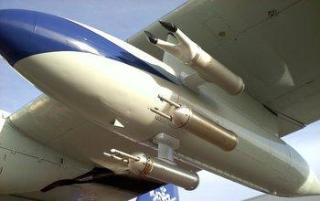Oct 6 2015
Watching clouds go by, swirls of white puff up and melt away. The changes mirror mixing within the clouds as drier air mingles with water-saturated air.
 The HOLODEC instrument, or Holographic Detector for Clouds, is mounted to and transported via a C-130 aircraft. Credit: NCAR
The HOLODEC instrument, or Holographic Detector for Clouds, is mounted to and transported via a C-130 aircraft. Credit: NCAR
New research led by scientists at Michigan Technological University, along with the National Center for Atmospheric Research (NCAR) and Mainz University, analyzes this mixing with holographic imaging and an airborne laboratory.
Results of a study using the new way of seeing clouds--and their unusual mixing behavior--are reported in the journal Science this week.
"Clouds are the most conspicuous and dynamic feature of the Earth's atmosphere," says Chungu Lu, a program director in the National Science Foundation's (NSF) Division of Atmospheric and Geospace Sciences, which funded the research.
"They play decisive roles in forecasting weather and assessing climate change," says Lu. "The initiation, development and dissipation of clouds depend on interactions between cloud droplets and their air environment. This study offers an important understanding of how these interactions occur at the finest scales."
Boundaries in the clouds
Sharp boundaries form as dry air completely evaporates some water drops and leaves others unscathed. The findings will influence models that help predict weather and climate change.
Raymond Shaw, a Michigan Tech physicist, looks at the smallest part of clouds: droplets. To understand groups of droplets, Shaw and NCAR researchers flew airplanes through fluffy cumulus clouds in Wyoming and Colorado.
Aboard the plane, the team took detailed 3-D images with an instrument called the Holographic Detector for Clouds (HOLODEC--after the "Star Trek" holodeck). These particular clouds were made up only of liquid water. The size of the drops is a key part of cloud formation and mixing.
"You can take a certain amount of water and divide it up into many small drops or just a few big drops," Shaw says, explaining that it's like having a lot of sand or just a few boulders. "And by dividing it up in different ways, you can change the optical properties of the clouds, making them brighter or darker, more or less reflective."
The differences affect how much sunlight makes it into the lower atmosphere--and can reflect, buffer or trap in heat.
The challenge, however, is that clouds don't blanket regions--let alone the world--in a uniform layer. On smaller scales within clouds, mixing affects the spacing between drops, what size they are and how they are distributed throughout the clouds.
Enter HOLODEC
The HOLODEC instrument, which is a tube about six inches in diameter and several feet long, samples a cloud volume about the size of a marker and provides unique insight into cloud mixing.
Jeff Stith, who manages the Research Aviation Facility at NCAR, compares this mingling to a marbled cake. The wet air, filled with droplets, is like red cake; the dry air is like white cake. Stith, Shaw and the team wanted to know how fine the boundaries are between red and white cake and how much pink cake there might be.
Using HOLODEC, the scientists observed clear boundaries--distinct lines between wet and dry air.
The size of the droplets remained unaffected. The ones that dissipated went away completely and the ones left behind stayed the same size, making a marbled cake.
Together the open space and large drops encourage clouds to grow. With enough mixing, the droplets tend to spread out more evenly, blurring the distinct boundaries.
From fiction to fact
Like its "Star Trek" counterpart, the HOLODEC needs a flying vessel.
In this case, the HOLODEC was carried on a C-130 airplane, maintained by NCAR and owned and supported by NSF, along with the University of Wyoming's King Air Research Aircraft, also supported by NSF.
The combination has been more than a decade in the making. Shaw says it all started with a prototype HOLODEC, machined and cobbled together over several months.
"It worked--then we had to figure out what to do with the data," Shaw says, recalling that the early years were spent tweaking the device and figuring out how to display droplets accurately. "Now, we've built a better instrument and refined the technique, and we are finally able to handle large amounts of data."
Looking at those data was only possible with high-end graphics cards, the kind favored by hardcore gamers. Further processing the data will enable Shaw and the research team to visualize mixing in clouds and provide insights into how to improve weather and climate models.
Layer cake of clouds
The challenges of understanding mixing in clouds have persisted for several decades. What the team found with the marbled cake distribution, or inhomogenous mixing, as scientists call it, goes against what most computer models assume for cloud dilution.
"It would be more accurate to say that some droplets are eroded away and that the ones that are left over are just as big as they were at the start," Shaw says, cautioning that the parameters of the study looked only at a single dry region and focused on water-only cumulus clouds. "What if we look in the tropics or in different cloud types? The process might be different."
Reviewing other conditions is possible with the airborne lab and HOLODEC. Gathering more data--and turning the data into computer modeling code--will enhance predictions for weather and climate, the scientists say.